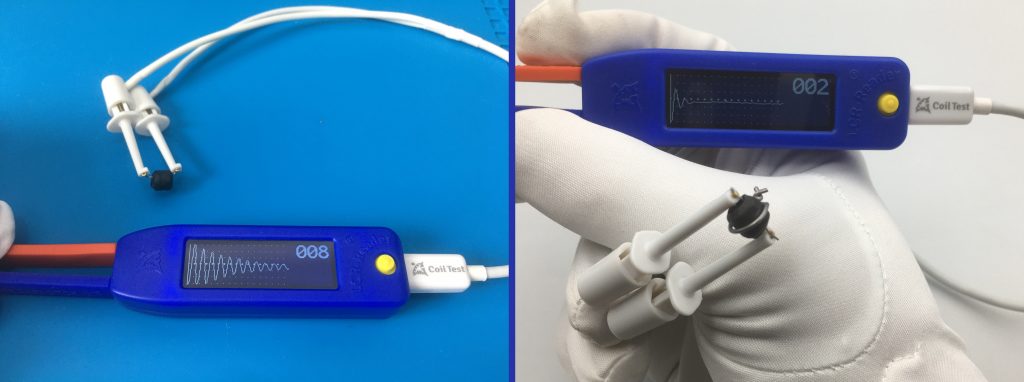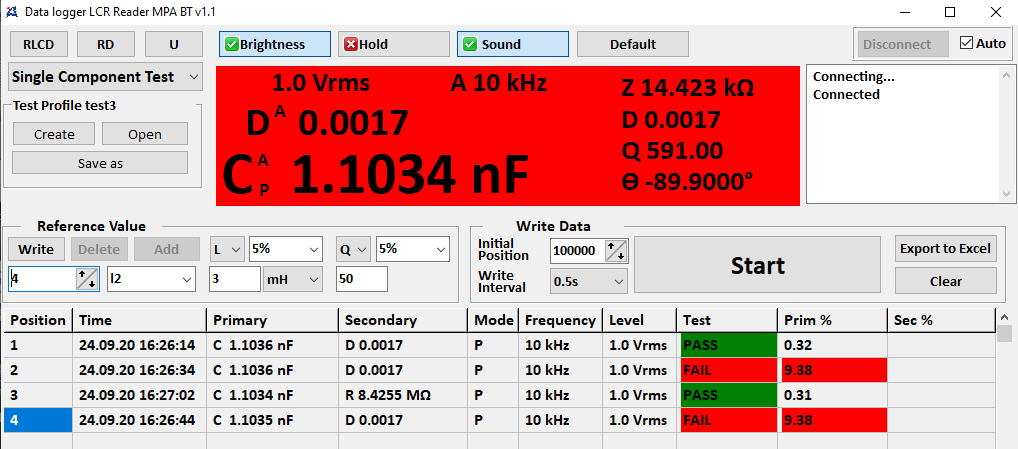Siborg is offering a fall sale for the month of October on most test devices in the LCR-Reader Store and Amazon sales channels. The sale includes LCR-Reader-MPA, MPA Bluetooth, Smart Tweezers and LCR-Reader devices. Siborg is offering up to 30% off until October 30th at 11:59 PM EST.
Month: September 2020
Test Results for the First Batch of the LCR-Reader-R2 Tweezer-meter
Siborg is continually working on updating the devices in order to offer their customers high accuracy devices while still being affordable. For over a year they have been working on a new model of their LCR-Reader devices, the LCR-Reader-R2. The new model offers a basic accuracy of 0.1% and features a record high 300 kHz test frequency. The new device is going to have the ability of using adjustable 100 Ohm and 1 kOhm signal source resistance allowing for better in-circuit testing.
The new model combines advantages of past models LCR-reader-MP and LCR-Reader-MPA due to the ability of switching the test signal source resistance from 100 Ohms as in MPA to 1 kOhm as in MP. Using 1 kOhm increases the stability of measurements and works much better for in-circuit measurements. But, lower source impedance effectively increases the actual test signal applied to the component under test, thus reducing the signal-to-noise ratio in some cases.
The device will feature a new CPU, which allows for 300 kHz test frequency. This frequency also may allow to better measure sub 10 nH inductors.
The new device will have better accuracy for measuring small capacitances and inductances and in-circuit measurements due to the ability to use higher source resistance. The higher accuracy is due to the use of adjustable signal source resistance of 100 Ohms and 1 kOhms, and the higher 300 kHz test frequency.
LCR-Reader-R2 will not feature the same features as LCR-Reader-MPA;
- Automatic and manual LCR, ESR, LED/Diode measurements
- 0.1% Basic Accuracy
- Automatic and manual test frequency including 100, 120 Hz, 1, 10, 20, 30, 40, 50, 60, 75, 100 and 300 kHz
- Three test signal levels: 0.1, 0.5, 1 Vrms
- Automatic Test Signal Reduction to 0.1 V for in-circuit measurements
- Parasitic offset removal using easy Short/Open Calibration
- Measures compoents to a 0201 size (0.3mm)
- Displays active and reactive impedance components
- Li-Ion battery and micro-USB charging port
- 1.5 oz. weight
- Backlit LCD display
- Gold plated test leads
Features that are only available on LCR-Reader-MPA
- AC/DC voltage measurements up to 5 V
- AC/DC current measurements
- Oscilloscope Transient Voltage up to 100 kHz
- Frequency meter
- Sine Wave Signal Generator
Each device comes with pre-installed set of gold-plated tips, NIST Traceable Calibration Certificate, Offset Calibration Board and hard-shelled carrying case. Other accessories include spare ergonomic bent-tips, spare battery and the LCR-Reader Kelvin Probe Connector.
New Bluetooth Data Acquisition Tool
Siborg has released their LCR-Reader-MPA Bluetooth Data Acquisition Tool with Logger program.
The LCR-Reader-MPA Bluetooth Data Acquisition Tool connects to PC and Android over a Bluetooth connection and allows users to remotely record measurements values in real time.
To use the LCR-MPA-BT Logger program, simply connect the BT dongle to the PC, turn on the MPA and only then start the program. The program will show that the device is connected and begin mirroring what is on the display in the program – showing the main impedance value, secondary value, signal test level, test frequency level, and equivalent circuit. There are also clickable parameters on the program’s main display for changing quick settings – frequency, test mode, etc.
The main feature of the program is the Pass/Fail assessment feature. Users are able to set custom profiles for each component in a predefined list (such as BOM). Users also set the desired values and test settings for the measured components. When testing, the main display on the program will turn red if the measured component does not meet the desired specs. The recorded values are marked red in the ‘Test’ column for fails, and green for pass.
There are two test modes: Single Component Test and Multiple Component Test. Single Component Test is best for testing the same type of component mutiple times. Multiple Component Test is best for full PCBs that have a range of different components with varied values. Users can set the name and the desired values for each component in the list. All measurement values, for both modes, can be exported to Excel.
Coil Ring Tester Attachment Now Available
Siborg has begun offering a new Coil Ring Tester for LCR-Reader-MPA.

The main difficulty for testing coils if that the LCR-meter shows almost no change in the impedance value if there is a short turn in the coil. An accurate way of finding short turns in a coil is by using the Ring Test technique. This method has been used in old AV equipment that us flybacks, motors, chopper transformers, deflection yoke windings, magnetic heads, main transformers and ore.
The coil ring method is based on Gibbs phenomenon that is a response of the system to a step excitation. When a capacitor is connected across the investigated coil and a pulse is applied to the parallel circuit. The wave form across the resonant circuit will create a decaying oscillation, with at least a few cycles if the coil is good. The oscillations will be strongly damped and only complete one or two cycles if there is a shorted turn in any of the magnetically coupled coils of the device. A short turn could also be applied, when applicable, to compare with and without a short turn. If there is no change, there is a short turn in at least one coil. Experience and comparison with a known good device will tell you what to expect.
The LCR-Reader-MPA is connected to the Ring tester using the micro-USB plug and connected to the coil under test using the hook connectors. Set the MPA to “winding turns” in the menu. When the device is set, the screen will show the response on the display. The example below shows a dramatic difference; when a shorted turn is connected, the display shows significantly higher dissipation factor and therefore a fewer number of oscillations following the impulse on the coil.

The Ring Coil Tester Attachment is currently only available from Siborg directly and from their Chinese distributor AI-Rox in Shenzhen.
MPA with Bluetooth Available Now
Siborg has released the MPA with Bluetooth connection in Canada, USA and China. The added Bluetooth capabilities boost the efficiency of LCR-Reader-MPA.

The device is identical to LCR-Reader-MPA with 0.1% basic accuracy and wide range of features, but now can send and receive data from PC, Android and iOS.
When connected with the Bluetooth dongle (for PC), the MPA will automatically send the measurement results in a string of comma separated values. This string represents the main impedance value, secondary value, measurement mode, type of series, test frequency. This data can be saved to a spreadsheet or other database for later analysis.
Users are also able to set custom profiles; set specific values that components must comply with. When a component is measured, it is granted a pass or fail depending on if it met the requirements.

When using the LCR MP Bluetooth Logger program, users can compare components to a pre-measured component. Users can use this program or other programs, like National Instrument’s LabView.
The ability to test and record the values in real-time is an exceptional ability for tasks where quality control is important but time is essential, such as production lines.
